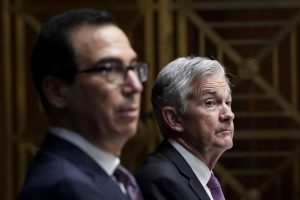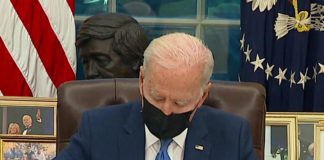NOVEMBER 19, 2020

Over to you, Steve. – Photographer: Drew Angerer/Getty
Treasury Secretary Steven Mnuchin on Thursday said he would not extend most of the emergency lending programs run in tandem with the Federal Reserve, a move the central bank immediately criticized, citing the fragile recovery.
The Fed’s exceedingly rare public response reflected a government divided on how to act as the pandemic surges across the nation, threatening a new wave of shutdowns and marking an inflection point of the economic recovery.
In a letter to Fed Chair Jerome H. Powell, Mnuchin not only said that several of the programs would wind down at the end of the year, but he also requested that unspent money allocated to the Fed under the first stimulus effort, the Cares Act, be reallocated by Congress. However, the Treasury Department does not have the sole authority to reallocate the funds and would need to secure Fed agreement.
The letter triggered a rare public statement from the Fed on Thursday evening.
“The Federal Reserve would prefer that the full suite of emergency facilities established during the coronavirus pandemic continue to serve their important role as a backstop for our still-strained and vulnerable economy,” the central bank said.
The Treasury Department’s move would end most of the Fed’s emergency lending facilities, as well as two highly-scrutinized programs — the Main Street lending program and the municipal liquidity facility — which issue loans to struggling businesses and local governments. Mnuchin also requested a 90-day extension for a few of the programs that operate through the markets.
The Treasury and the Fed jointly established a suite of emergency programs in the early days of the pandemic — and they have at times clashed over how the programs should be structured and how effective they can be. The shared responsibility also means that certain decisions can’t be made by either Powell or Mnuchin alone, setting the stage for the surprisingly outward-facing clash.
Raging virus triggers new shutdown orders and economy braces for fresh wave of pain
“There have been disagreements in the past, but they’re usually handled out of public sight,” said David Wessel, director of the Hutchins Center on Fiscal and Monetary Policy at the Brookings Institution. “It’s unusual. But then these are really unusual times.”
The decision to curb the Fed’s lending powers comes as new economic data signals the U.S. economy is being newly battered by a spike in coronavirus cases, triggering a new wave of government-ordered closures, restrictions and shutdowns. Unemployment insurance claims rose last week for the first time since early October.
Democrats swiftly criticized Mnuchin’s decision as a politically motivated attempt to hurt the economy President-elect Joe Biden is set to inherit. They expressed concern that Senate Republicans could push for the funding to be repurposed in the next stimulus package, decreasing the overall amount Congress approves in economic relief.
“Secretary Mnuchin is removing critical support from a weak economy against the Federal Reserve’s wishes. This is economic sabotage,” Sen. Ron Wyden (Ore.), the ranking Democrat on the Senate Finance Committee, said in a statement. “Secretary Mnuchin is salting the earth in an attempt to inflict political pain on President-elect Biden.”
There is also the broader concern among Democrats and economists that ending programs would eliminate a backstop to the markets before the recovery is fully formed. In a statement Thursday night, Neil Bradley, executive vice president and chief policy officer at the U.S. Chamber of Commerce, called for the programs to be extended and warned that “American businesses and workers are weary of these political machinations when they are doing everything in their power to keep our economy going.”
The Fed has given no signal that it’s ready to wind down these programs. Earlier this week, Powell said that the Fed was committed to using all of its tools “for as long as it takes until the job is well and truly done” and that “when the right time comes, and I don’t think that time is yet or very soon, we will put those tools away.
At a press conference earlier this month, Powell said that the Fed was only beginning to turn to questions around extending the facilities.
“And in terms of the process, this is a decision that of course we have to make and will make jointly with the Treasury Department,” Powell said.
As Washington scrambles for more bailout money, the Fed sits on mountain of untapped funds
Although the Main Street lending program and municipal liquidity program have been widely criticized for their onerous loan terms and meager uptake, Fed officials have argued for months that it would be premature to cut off that support until the recovery is sustained and the economy survives the dark winter ahead.
In March, Congress allotted $454 billion to the Treasury Department to support the central bank’s emergency lending programs, including those for struggling businesses and local governments. Those lending programs have recently become a kind of political football.
Republican lawmakers, including Sen. Patrick J. Toomey (R-Pa.), who could soon take the helm of the Senate Banking Committee, said those programs have served their purpose.
In a statement Thursday evening, Toomey said Congress’s intent with the Cares Act made clear the programs were meant to be temporary.
“These facilities, which were established in response to the unprecedented market turmoil caused by the covid-19 pandemic earlier this year, have successfully achieved their intended purpose: stabilizing credit markets so private credit could once again flow to businesses, states, and municipalities,” Toomey said. “These temporary facilities helped to both normalize markets and produce record levels of liquidity.”
Even so, much of the money entrusted to the Fed has hardly been touched, and it’s unclear how much money could get out the door given specific rules about how the money should be spent. Of the $454 billion pot allotted from the Treasury Department under the Cares Act, only $195 billion has been specifically committed to cover any losses the Fed might take through its programs, including through loans that companies fail to repay. As of last month, the remaining $259 billion still has not been committed to any of the Fed’s specific programs or for any other purpose.
Courtesy/Source: Washington Post









































































































